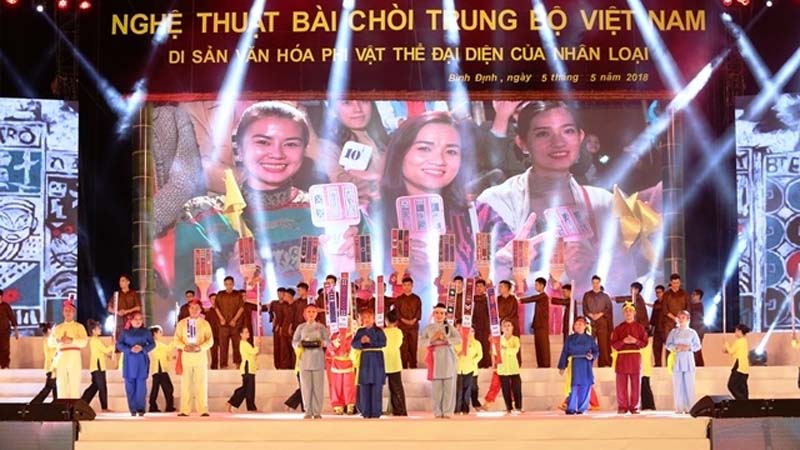
A ceremony was held in Binh Dinh province on May 5, to receive a certificate recognising bai choi, a form of folk singing popular in central Vietnam, as a UNESCO intangible heritage of humanity.

A
bai choi performance at the ceremony
The event was attended by Prime Minister Nguyen Xuan Phuc and the
UNESCO chief in Vietnam Michael Croft, as well as foreign diplomats and artists
from provinces where bai choi is practised.
An indispensable cultural element of people in the central provinces, the
content ofbai
choisinging reflects the
love for the homeland, community relationships and life experiences.
The art also helps to shape the qualities that
characterise the people of central Vietnam: frankness, sincerity,
simplicity, toughness, optimism and hospitality.
Speaking at the ceremony, PM Phuc stated that cultural
heritages are a valuable asset of communities and the preservation and
promotion work is significant for nurturing patriotism and strengthening
national solidarity.
For his part, Binh Dinh, Chairman Ho Quoc Dung, affirmed
that the provinces where bai choi is practised are determined to effectively
implement a scheme on promoting the heritage.
The ceremony also featured a wide range ofbai
choiperformances as well as
other songs and dances typical of the central region.
Source:NDO
With an increasingly vibrant and widespread emulation movement aimed at building cultured residential areas and cultured families, Yen Thuy District has been making steady progress toward improving both the material and spiritual well-being of its people, while fostering a civilized, prosperous, beautiful, and progressive community.
Once lacking recreational spaces and community facilities, Residential Group 2 in Quynh Lam Ward (Hoa Binh City) has recently received attention for the construction of a new, spacious, and fully equipped cultural house. The project followed the model of state support combined with public contributions in both labor and funding.
The "All people unite to build cultural life" movement, which has been effectively integrated with Kim Boi district’s socio-economic development goals, is fostering a lively spirit of emulation across local residential areas, hamlets, villages, public agencies, and enterprises. In addition, through the initiative, traditional cultural values are being preserved and promoted, while community solidarity and mutual support in poverty reduction and economic development are being strengthened.
A working delegation of the Hoa Binh provincial People’s Committee led by its Permanent Vice Chairman Nguyen Van Toan on June 11 inspected the progress of a project to build the Mo Muong Cultural Heritage Conservation Space linked to tourism services in Hop Phong commune, Cao Phong district.
Born and growing in the heroic land of Muong Dong, Dinh Thi Kieu Dung, a resident in Bo town of Kim Boi district, in her childhood was nurtured by the sweet lullabies of her grandmother and mother. These melodies deeply imprinted on her soul, becoming an inseparable part of her love for her ethnic group's culture. For over 20 years, this love for her hometown has driven Dung to research, collect, and pass down the cultural values of the Muong people to future generations.
In the final days of May, the Ethnic Art Troupe of Hoa Binh Province organized performances to serve the people in remote, mountainous, and particularly disadvantaged areas within the province. These were not just ordinary artistic shows, but they were the meaningful journeys aimed at spreading cultural values, enhancing the spiritual life of the people and contributing to the preservation of ethnic minority cultural identities.


